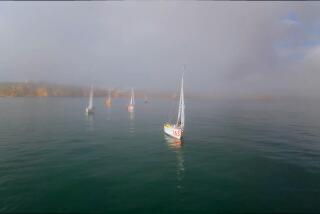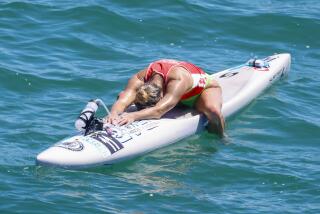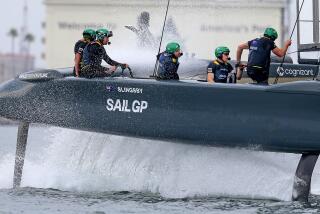The Eagle Has Landed : Valentijn’s New 12-Meter Yacht in Newport Harbor Is Designed With the America’s Cup Races in Mind
- Share via
Australia’s surprising win in the America’s Cup in 1983 split the American yacht racing fraternity in a dispute that remains unresolved: Whether to blame Dennis Conner or his red boat Liberty.
Conner sailed it. Johan Valentijn designed it. Take your pick. Step right up and take your best shot.
But while selecting the ripest tomato, you also could consider the theory that the Aussies just sailed very well and made the most of an innovative keel with wings.
Valentijn, who now has created Eagle for the Newport Harbor Yacht Club syndicate, is convinced that the keel’s largest value was psychological.
“The keel was not the difference,” he said. “The psychological warfare the keel created was the difference.”
Out of the water, Australia II’s modesty was always protected by a skirt of tarpaulins around the hull. That, the Aussies and many Americans claim, drove Conner crazy.
Valentijn: “When Dennis Conner doesn’t know what the other guy has, he gets very worried and uptight. There were some people in the syndicate that kept talking forever about the Australian keel. For a while all their energy was taken up with, ‘What can we do about the Australian keel?’ It was just wasting energy.”
Nevertheless, when the Eagle landed on the water at Newport Harbor Sunday, you can bet it had a winged keel, just like Aussie II, but few knew for sure because, until it was launched, it, too, was shrouded, just like Aussie II.
“Yeah, well, that’s part of the fun,” Valentijn said, smiling.
Valentijn claims there is no paranoia in the Eagle camp. You want to see the keel? He’ll show you the keel.
“If somebody copies your keel or any other part of your boat, it means he’s behind you,” Valentijn said. “And then all he has is a copy. He doesn’t know how it works.”
Valentijn is confident that the Eagle will work just fine. But he always feels that way.
In ‘83, he said, “There was never one moment in my mind I had doubt we would win. I felt we were at least equal to or better than they were.”
Valentijn said he even knew about the secret in Aussie II’s belly.
“But I didn’t feel very worried about it. After I saw it I felt even more confident that we’d be able to beat them. But we did not, so I felt pretty down for a while.”
Conner said Aussie II was a better boat, an indirect slight of Valentijn.
“I know that’s what he said,” Valentijn said. “Everybody needs an excuse. I’m not blaming anybody. Yacht racing is partly luck. It was a dramatic loss because it was the America’s Cup, but it’s not like it was four-zip, and the last race we were ahead. Anybody who was part of it should have been proud of it.”
Unlike many others, he didn’t second-guess Conner.
“It’s so easy to sit in a chair and tell you what the other guy should do. I’m not gonna get involved in the match-racing tactics. When you’re out on the water, you have to make your own decisions. I’m not gonna blame Dennis. He’s one of the best sailors in the world.”
Eagle is Valentijn’s fifth 12-meter, although there was some question after ’83 whether he would ever be commissioned to design another. He seemed destined for a spot in the engineering hall of fame next to the guy who drew up the Edsel.
Two Americans who are determined to retrieve the Cup in ’87 disagreed. One is George Tooby, who was organizing the Eagle group. The other is Dennis Conner.
“He (Conner) wanted me to be in charge of his whole design team,” Valentijn said. “I thought about it very carefully, but with the people he had put on his design team at that time I thought it was going to be a big contest of who was responsible. I decided I didn’t want any part of that.”
Tooby knew Valentijn from when the latter worked for Sparkman and Stephens and helped build a one-ton racer and a cruising boat for him. The ’83 defeat didn’t shake Tooby’s confidence in Valentijn, either.
“Not a damn bit,” Tooby said. “He’s the best 12-meter designer there is. Those boats were even. You couldn’t tell the difference in speed between them. Each of them won three races before the Australians won the seventh race by, what--47 seconds? How close can you get?”
Valentijn, 37, grew up in the Netherlands and became an American citizen in 1981. He also designed 12-meters for Australia and France until the rules were tightened restricting foreign input into a given boat.
“They made a new rule especially for me,” Valentijn said.
His heart, soul and reputation have gone into Eagle. It’s all his, even to the outsized and ostentatious logo of an Eagle trailing American colors in its talons on both sides of the gray hull--”the most radical paint scheme in America’s Cup history,” one Cup historian called it.
“I didn’t ask anybody,” Valentijn said. “I just did it. It’s hard to visualize, so if you ask opinions all you get is a bunch of people who can’t decide what they want. You have to do what you like and what you feel is right. I’m also known to be very stubborn.”
Rod Davis, Eagle’s skipper, had reservations when he first saw the paint job.
“I told Johan, ‘It had better be fast, because we’re gonna be noticed out there,’ ” Davis said.
All of the leading syndicates have leaned heavily on research and computer technology to assist them in their designs, all looking for an Australian-type “breakthrough” that may have been more myth than fact.
“I think the top four or five boats are going to be awfully close in speed,” Valentijn said. “I think you’ll find that everybody has worked so hard to get something better that everybody will make similar kinds of improvements.
“But the chance of having a breakthrough boat is one in a million. Nobody is going to walk away with the America’s Cup.”
America’s Cup Notes Eagle, designed to the 12-meter formula, is 66 feet long, with a 47 1/2-foot waterline and a 12 1/2-foot beam. Its total displacement is 30 tons, 80% of which is lead ballast in the keel. The mast stands 82 feet above the deck. Like all 12-meters except New Zealand’s two fiberglass boats, Eagle is built of aluminum. . . . The syndicate will build only the one boat, unlike Dennis Conner’s Challenge ’87 and the New York Yacht Club’s America II, which have three new craft apiece. . . . Rod Davis hoped to start sailing the boat out of Long Beach late this week. Magic, the syndicate’s test boat, will be a benchmark for Eagle’s performance, and three other syndicates--Heart of America from Chicago, Canada II and Italia--have indicated they will join in the test sailing before shipping to Australia for the start of eliminations in October.


